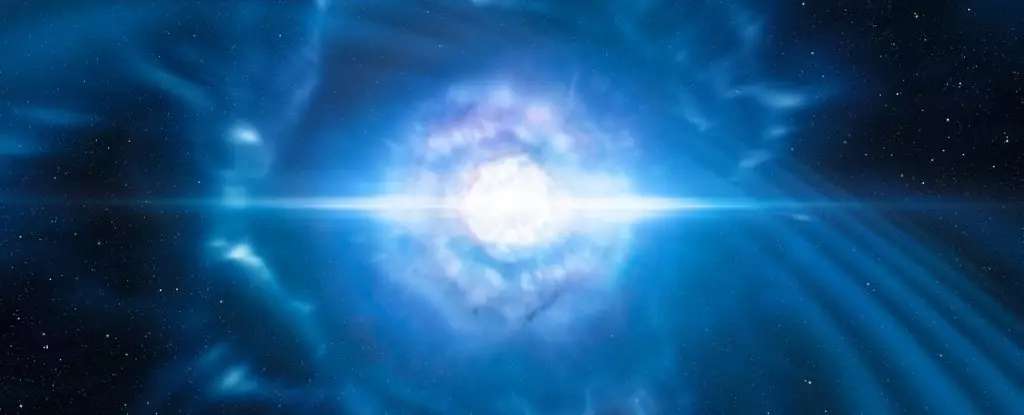In a landmark moment for astrophysics, August 2017 marked humanity’s first gaze into the cataclysmic wonder of neutron star collision. The astronomical event, which resulted in the formation of a kilonova named AT2017gfo, was a momentous occasion that provided an unprecedented opportunity to study the aftermath of such a colossal explosion. Scientists around the globe eagerly observed the gravitational waves emitted as the two neutron stars spiraled into a merger, ultimately giving birth to a black hole. The data gleaned from this event has continued to inspire extensive research, allowing astrophysicists to grasp phenomena that were previously enigmatic.
The collaboration among multiple observatories enabled researchers to intricately reassemble the explosive narrative of AT2017gfo. A team led by astrophysicist Albert Sneppen at the Niels Bohr Institute utilized observations from various telescopes around the world, including those in Australia, South Africa, and the Hubble Space Telescope. The disparate data collected over time revealed a transformative spectacle of hours in which the evolving kilonova displayed complexities reminiscent of the birth of the Universe itself. The excitation of elementary particles, their subsequent cooling, and eventual combination into heavier atoms created a rich tapestry of events that niche telescopic views alone could not capture.
Interestingly, the nature of AT2017gfo’s aftermath bore striking parallels to the Big Bang—a primordial explosion first theorized to set the stage for the existence of everything we observe in the cosmos. Just like early cosmic events, the kilonova’s short-lived period of intense heat represents a crucial phase in the evolution of matter, as particles whirled chaotically before settling into the first stable forms of matter.
One of the most tantalizing implications of the AT2017gfo collision was its role in generating heavy elements, a process often attributed to cataclysmic occurrences like supernova explosions. While traditional stellar fusion entails the creation of elements up to iron, the greater challenge of synthesizing heavier elements demands the unique conditions found in extraordinary cosmic events. Observations during the kilonova revealed the presence of strontium among its outflows—a significant indicator of these heavy element production factories at work during such explosions.
By meticulously analyzing this data, researchers highlighted the potential of kilonovae as essential sites for synthesizing r-process elements. These are isotopes formed through rapid neutron capture, contributing to the universe’s inventory of elements. The implication here is profound: neutron star collisions can be understood not just as destructive cosmic events but also as formative processes contributing to the elemental makeup of the universe.
Recombination: A Cosmic Echo
Delving deeper into the warm embrace of the kilonova, researchers found an analogy to a pivotal cosmic phase known as the Epoch of Recombination. This era, occurring approximately 380,000 years after the Big Bang, marked a critical transition where the universe cooled sufficiently for free electrons and protons to bond and form neutral hydrogen atoms. During AT2017gfo, the violent initial conditions shortly following the neutron star merger created a similar soup of plasma, allowing researchers to examine how elementary particles merged during the kilonova’s evolution.
The implications of the kilonova phenomena extend beyond mere observation. By witnessing the formation of atomic structures in real-time, astrophysicists can glean insights into the micro-physics of such cosmic explosions. As physicist Rasmus Damgaard articulated, the experience becomes akin to “seeing the universe from the outside.” This metaphor eloquently summarizes the rich data that has emerged from examining the temperature and responding elemental chemistry in these transient atmospheric conditions.
The discovery of AT2017gfo opens a plethora of avenues for future research. As scientists continue to piece together the cosmic puzzle from past events and anticipated collisions, the window into the early universe grows clearer. Neutron star mergers not only amplify our understanding of elemental formation but also serve as cosmic laboratories to probe the fundamental forces that govern our universe.
We find ourselves standing at a crossroads of discovery. Each observation, each kilonova, beckons further exploration into the splendid yet violent dance of cosmic evolution. The ongoing analysis of events like AT2017gfo ensures that we are not merely passive observers but active participants in a saga that stretches across the cosmic timelines—an intricate narrative of creation, destruction, and rebirth in the grand tapestry of existence.


Leave a Reply